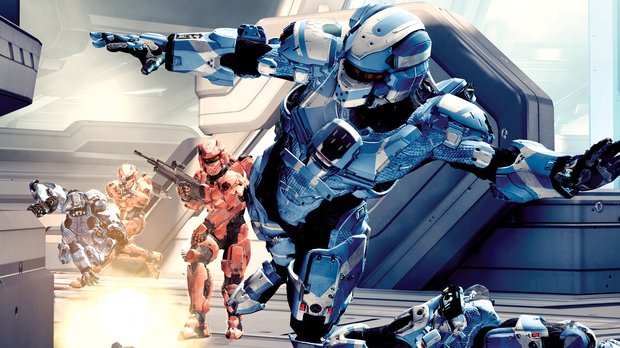When 343 Industries came into being in July 2009 – the date of a filing by Microsoft that named the studio taking responsibility for Halo after the series’ most genocidally conscientious character – it had a long list of things to do. Small things, such as growing from scratch a studio that could operate at the very peak of blockbuster development; reintroducing the most successful, recognisable and important character on Xbox; reinventing the most successful game on Xbox (while simultaneously making it the same, obviously); and doing it all under the shadow of a fixed-in-stone autumn 2012 release date for the game it had been created to deliver: Halo 4.

Actually, that’s the short version. 343 was also to assume gradual control the entire Halo universe, from plushie grunts to tie-in novels, from series creator Bungie. Not to mention the fact that each of the items on the new studio’s to-do list unpacked into a complicated subset of tasks and problems. For instance, making a new game starring Master Chief also meant winning back confidence from a fanbase who’d been burned – or at least disappointed at high temperatures – by Halo 3’s forceful pre-release invitation to ‘Finish the fight’, which actually ended in a narratively ambiguous abandonment of the game’s hero (a phrase that, to be fair to the game’s marketers, is substantially less poster-friendly).
This in turn required the return of something like Halo’s good old days of uncomplicated zealotry. The rabid anti-human thrust of the Covenant in Combat Evolved told us exactly what we needed to know about the dangers faced by Master Chief – an enemy bent on humanity’s destruction – and stopped us having to wonder for too long about the humanity of our superman protagonist himself. Since then, Halo had undergone a kind of narrative drift: while the game was revolutionising online multiplayer and driving the expansion of Xbox Live, Master Chief was traversing the fog of war and having, if not an existential crisis, then a momentary pause as to where he should fire his gun next.

And that’s why, from a certain distance, 343’s daunting catalogue of things to do and solve actually becomes just one thing: give us back Master Chief. This is Halo 4’s most significant charge, and its biggest achievement. It reconnects us to Master Chief, and it reconnects Master Chief to the mythological foundation of the series in the shape of the Forerunners. In so doing it presents him, us, with the kind of clear-cut threat to humanity – Forerunner warrior-general The Didact, face snarling and hand hovering over a doomsday device – that Master Chief needs to be set against, in order to make sense, in order to be a hero we can enjoy.
What this means in practice is that many of Halo 4’s big gains come from falling back on the template of Combat Evolved. The Chief is reunited with Cortana, who’s still a compensatory mouthpiece, balancing our hero’s stoicism with a flow of fast-talking exposition, and still so well written and performed that nobody cares. It’s great to have her back. The pair find themselves drawn to another Forerunner world which, like the lush ringworld of Master Chief’s first adventure, offers a mysterious, grand landscape of revelation and exploration. And, after the grave sense of being cast adrift at the close of Halo 3, it turns out this new world and our heroes aren’t so far away after all: within moments the Covenant are back in the picture, and the cannon fodder of the UNSC aren’t far behind. From the very start, Halo 4 seems familiar. And that seems like a very good idea.
Accordingly, the action is no reinvention. In fact, that’s quite possibly why this breakaway sect of the Covenant has been co-opted into the game, to ease us in with the familiar sound of plasma rifles and grunt squeals, the practised rhythms of Elite ducks and cover dodges. It’s a way of making everything like it was, in order to prepare us for how they are going to be in this new part of the Chief’s journey. And how they are going to be involves Halo 4’s most significant contribution to the series and its lore: the Prometheans.
The Prometheans are the new enemies that the Chief and Cortana find on the Forerunner planet, and they are many things. Firstly, they are better than the Flood. Empirically and unequivocally: they are more fun to fight, more interesting to look at, and their backstory is gruesome, compelling stuff. Both inside and outside of the fiction, they are clearly designed to be 343’s antidote to the Flood, a digital species superseding the creatures of flesh and decay, a tacit promise that Halo will never again make you walk through a level like the inside of a giant bowel, honest.
Sign up to the GamesRadar+ Newsletter
Weekly digests, tales from the communities you love, and more

They are also quite a lot like the Covenant. They have a three-tiered hierarchical structure led by the towering Knights, reminiscent of Elites with an internet disco makeover, and backed up by fluttering drones and packs of small, grunt-like canine units. This isn’t a bold enough move to install the Prometheans alongside the Covenant in terms of distinctiveness or durability. Our new enemies do not measure up to their forebears – but then, they don’t need to. Their job – the job of Halo 4 itself – is to facilitate the return of Master Chief, and they do just that. They provide the three-way battles and tight, clustered fights that make the game feel so much like a return to the series’ basics, the 30 seconds of fun, the Assault on the Control Room and the building blocks of Halo. Asking them to be iconic on top feels almost ungrateful.
If the campaign was a measured success – disentangled, course corrected, a solid foundation – then Halo 4’s multiplayer found itself at a crossroads. For years, Halo ruled Xbox Live with a steady hand – literally so, with its combination of perfectly weighted movement and aiming and a skill-matched, level-playing-field approach to multiplayer. But the ruthless quality of Call of Duty created a hungered trend for frenetic shooting powered by custom loadouts, unlockable armouries and killstreak rewards. Bungie had already made concessions to this trend with Halo: Reach’s power-ups, and in designing Halo 4 343 was faced with a decision to double-down or back up.

In the end it doubled-down. Halo 4 is a conscious, pragmatic step away from the more deliberate pace of the classic Halo online game, one that at least partially embraces the speed and brutality of Call of Duty. Sprinting might be the most fundamental change, upping the speed at which the game is played and the mindset of those involved. Frantic, fast decisions match the need for furiously quick reactions. This is not your older brother’s Halo.
Other things your hypothetical sibling might be confounded by include custom loadouts, which fundamentally alter the uniformity and tactical balance of the series by allowing for individual combinations of primary and side arms, updated versions of Reach’s armour abilities and CoD-style passive perks called Tactical Packages and Support Upgrades. Finally, as if in recognition of a standard new feature set for online shooters, Halo 4 includes Ordnance drops, which replicate CoD’s killstreak rewards.
And here’s the thing die-hard fans of Halo multiplayer and veterans of early 2000s LAN parties don’t want to hear: this was the right thing to do. 343 chose the right road. Halo’s classic balance and setup was a beautiful thing, but the compelling, frustrating and frenzied mechanics of CoD can’t be uninvented, and they are the new normal. Players vote with game time and discharged rounds – and ignoring them would be settling for second place and nostalgia. As with the campaign, 343 might not have aced multiplayer at the first attempt, but it took bold strides and set out the beginnings of a vision that is, at least, not standing still (those who resolutely refuse to do anything other than stand still are also covered, and can look forward to the arrival of Halo 2’s untouched multiplayer in the Master Chief Collection). Assuming responsibility for a series as big and as valuable as Halo is like waking up behind the controls of a UNSC Infinity-class destroyer and having to learn what all the buttons do in the cockpit, how to repair the elevators, the ins and outs of the cleaning rota and everything else, all while trying not to crash.

Spit the word out, but Halo is a transmedia phenomenon, and from a standing start, 343 is in charge of it all. Halo 4 might not be a triumph, but it is a success – it gives us the Chief, a fresh start and a new direction – and with Halo 5 Guardians now looming large, we can see how those necessary changes are being expanded on, used as a foundation for 343's new, and sternest challenge.
Click here for more excellent Official Xbox Magazine articles. Or maybe you want to take advantage of some great offers on magazine subscriptions? You can find them here.
The official source for everything Xbox One, Xbox 360, and Xbox Series X. We're also a magazine, covering all things Xbox in the UK and the US. Originally established in 2001, the magazine was discontinued in April 2020.



